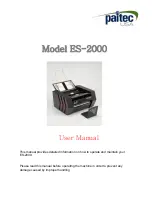
Manual-6
OPERATION
RIAA PHONO/LINE INPUTS
Input channels 1 through 4 each have a dedicated preamplifier.
A rear panel switch allows setting these preamps for PHONO
or LINE level signals.
Make sure you have the switch in the correct
position for your application.
The source selectors for Input chan-
nels 1 - 4 may select the dedicated PHONO / LINE preamplifier
or one of the five stereo AUX Inputs as the source.
With normal program material playing, set the INPUT
GAIN control to a level that causes the SIG / OL indicator to
flash
green. The SIG / OL indicator should
not
flash red. This
will ensure optimum signal to noise ratio and dynamic range. If
INPUT GAIN controls are set too high, you may not have the
required headroom for mixing multiple Inputs. If your levels are
set too low, signal-to-noise ratio is compromised.
In addition to optimizing noise and dynamic range, prop-
erly setting INPUT GAIN allows the MIX LEVEL control to
operate predictably over its entire range. The taper of the MIX
LEVEL control is
non-linear
and will have
different
attenuation
verses rotation characteristics depending on its position. As can
be seen in the figure below, if you are mixing between 30% and
60% of rotation, MIX LEVEL will behave much differently than
if operated between 65% and 95% of rotation.
the INPUT GAIN SIG / OL indicator to accurately indicate the
signal level. Adjust the MIC GAIN so the
red
OL indicator just
stays off during the highest signal peaks (if a microphone is in
use,
yell into it
). The MIC GAIN control should only have to be
set once for the source in use. Use the front panel INPUT GAIN
control for trimming the gain after installation.
Next adjust the rear panel MIC 1 and MIC 2 BASS and
TREBLE controls for the desired tonal quality. If you add a lot
of BASS or TREBLE boost, you may want to readjust the MIC
GAIN control to avoid possible overloading.
MIC 1 and MIC 2 each have an ENGAGE switch to the
right of the Input Selector. For a mic signal to be active, the
selector must be set to MIC
and
the MIC ENGAGE switch set
to ENGAGE (
up
).
When
either
of the switches is set to the ENGAGE posi-
tion, the BOOTH OUTPUT is ducked (attenuated) by 12 dB
(about ¼
th
) to reduce potential feedback. If you do
not
want the
BOOTH OUTPUT to duck when a MIC source is engaged,
you can remove the top cover and set the internal jumper accord-
ingly. There is an independent Ducker select jumper for MIC 1
and MIC 2.
It sounds like a lot of trouble to set the input stages up cor-
rectly, however, you will be amazed at how much better your
performance sounds.
MIX LEVEL
With the Input stages properly adjusted, you are free to use the
MIX LEVEL control for
mixing
. For most applications, channels
will be mixed at about 70% to 100% rotation. BOOTH and
HOUSE level controls then set the output volume. The MAS-
TER SIG / OL indicator displays the signal level of the
mix
. The
Green SIG indicator should flash or remain on. The Red OL
indicator should remain off (it may flash occasionally, but if it is
on every beat it is too hot). To correct an overload condition, one
or more of the MIX LEVEL controls must be turned down. The
MASTER SIG / OL indicator monitors the signal before
and
after the tone control, so if you use a lot of boost, remember to
monitor this indicator.
TONE CONTROLS
The MP 2016S uses high-performance tone control circuits
that isolate the signal into three bands. The level of each band
is independently controlled, and then recombined. This topol-
ogy provides full “kill” for TREBLE, MID and BASS. If all
three bands are set to the same level, there will be no change in
frequency response,
only
amplitude
. It is the
difference in settings
that determines the tonal quality of the signal. These advanced
tone controls provide excellent dynamic response with fixed
phase shift. Control is smooth and predictable. The tone controls
can isolate beats, vocals and “high-hat,” as well as adjust general
tonal quality. Remember that the dedicated Mic tone controls
(on the rear panel) are used to equalize the Microphone Inputs.
MIC / LINE INPUTS
Input channels 5 and 6 each have dedicated preamplifiers. A rear
panel switch allows setting these Inputs for MIC or LINE level
signals.
Make sure you have the switch in the correct position for
your application.
While these Inputs are designed for use with
dynamic microphones (no phantom power) or wireless micro-
phones with line level output, they will accept just about any
mono signal. While balanced operation is highly recommended,
these Inputs may be operated unbalanced with short cables to
the source (less than 10 feet or 3 meters). The source selectors for
Input channels 5 and 6 may select the dedicated MIC / LINE
preamplifier or one of the five stereo AUX inputs.
Prior to permanent installation
, adjust the preamplifier
GAIN, BASS and TREBLE controls (located on the rear panel)
for the intended source.
In addition to the MIC / LINE switch, each preamplifier has
a rear panel MIC GAIN trim. To properly set the MIC GAIN,
set the front panel INPUT GAIN control to “10.” This allows
Mix Level Taper
Rotation
10
10
0
20
20
30
30
40
40
50
50
60
60
70
70
80
80
100
100
90
90
Attenuatio
n




























